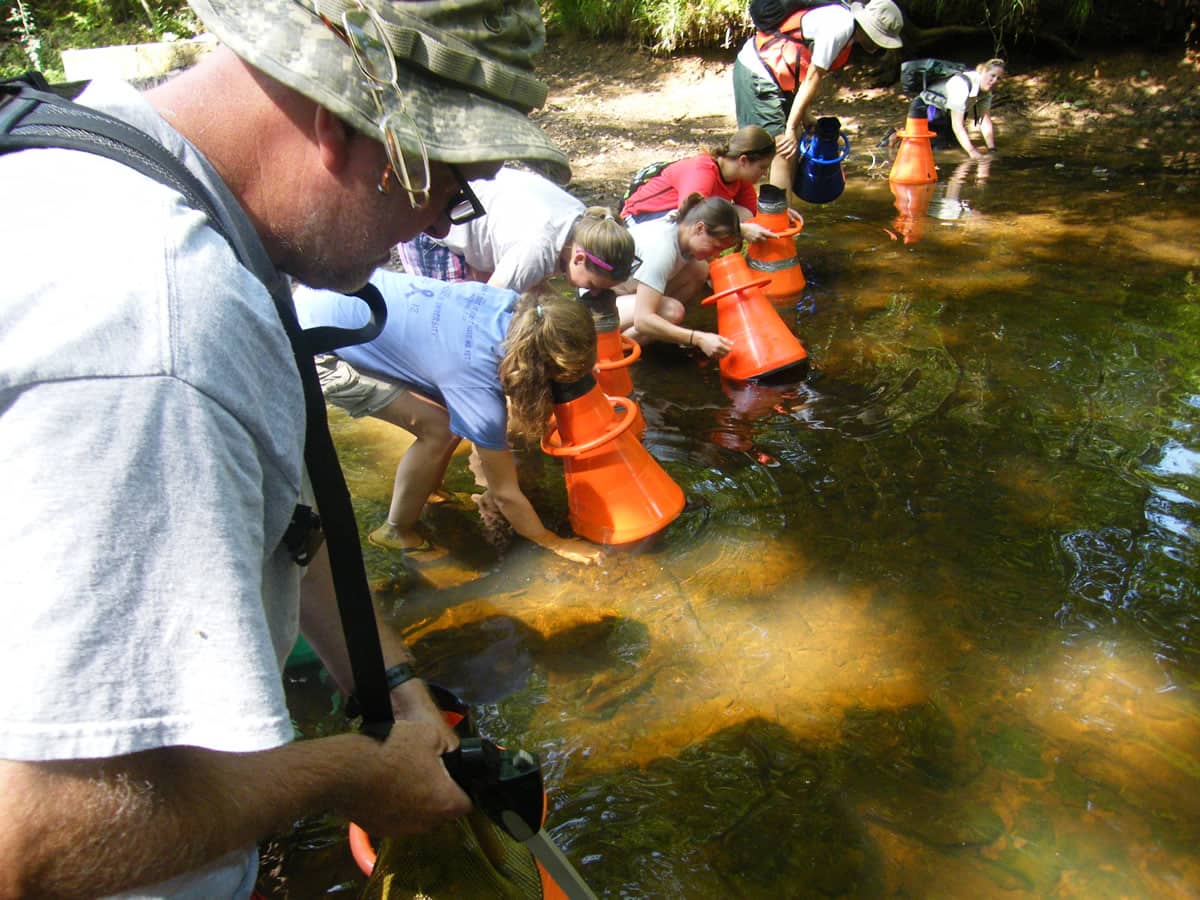Two Montgomery, North Carolina County Dams Removed from the Little River Basin
OutdoorHub 09.13.12

Two trackhoe excavators pound away at the narrow concrete and rock wall of the decrepit Troy Reservoir Dam No. 1, which stretches across Montgomery County’s Densons Creek, a tributary of the Little River. On a nearby bridge a small group gathers to watch their efforts to improve the health of this stream bear fruit.
“Removing this dam is an opportunity to help the town of Troy further enhance Densons Creek’s natural aquatic community, in turn helping meet local economic and conservation goals,” said U.S. Fish & Wildlife Service biologist Laura Fogo, who has spearheaded the project. “The removal of Troy Reservoir Dam No. 1 is part of a larger, landscape-scale effort to restore the streams of the Little River watershed.“
The Troy Reservoir Dam No. 1 reached six feet high and stretched 83 feet across the stream channel. It was built more than fifty years ago to supply water for the town, though it has long since quit serving that purpose.
Currently water can flow through and beneath what remains of the dam, however during high flow water builds up behind the concrete and rock wall.
The removal of the dam was done in close concert with the town of Troy, which owns the 173-acre nature preserve containing the dam site. In total, the town has protected over 17 miles of stream corridor above and below the removal site, establishing public walking trails which connect to Uwharrie National Forest.
The removal of the Troy Reservoir Dam No. 1, and the recent removal of a privately-owned dam nearby, come after months of work by the U.S. Fish & Wildlife Service, American Rivers, and other partners, including local landowners. Removal of Troy Reservoir Dam No. 1 opens up three miles of stream to fish and other animals whose upstream movement was checked by the decrepit dam.
“In removing a decrepit dam, we gain a tremendous amount of habitat restoration for relatively little effort.” said U.S. Fish & Wildlife Service biologist Laura Fogo.
American Rivers’ Lynnette Batt added, “These removals reflect the work of a lot of people, from private landowners to federal agencies, coming together to improve the health of these streams. It’s encouraging to see such cooperation for the good of North Carolina rivers.”
Decrepit dams can be a safety hazard for paddlers and other river users, and can prevent fish and other aquatic animals from moving up or downstream to take advantage of quality habitat.
“For larger, functioning dams, these passage issues can be addressed by the construction of fish ladders, or even elevators, that give fish, both game and non-game, an opportunity to by-pass the dam,” explained Mark Cantrell, a biologist with the U.S. Fish & Wildlife Service. “For small dams like these, that no longer serve any purpose, removal really is the best option.”
In addition to game fish, the nearby Little River and other area streams have been documented to hold a number of rare aquatic animals, including the Atlantic pigtoe, brook floater, and Carolina creekshell mussels – all considered endangered by the state of North Carolina; and the Carolina redhorse fish, a large fish that feeds on crayfish, insects, and other animals found on the stream bottom. Additionally, there are historical records of the American eel in the Little River. Found in streams from Canada to South America, all reproducing American eels leave their home rivers and journey to the Sargasso Sea, in the Atlantic Ocean, to reproduce. The young then return to fresh water until their time to reproduce. This long migration has become truncated as dams were built, limiting how far upstream the eels can swim. Efforts to remove decrepit dams, paired with providing eels a way around larger, functioning dams, mean these fish will be able to extend their range up into rivers, eventually approaching their historical distribution.
Since the 1997 removal of the Quaker Neck Dam on the Neuse River, dam removal has been seen nation-wide as an increasingly important way to improve stream health by opening up habitat to fish and other aquatic animals and restoring natural water flow. The U.S. Fish & Wildlife Service, American Rivers, and other partners are working with communities across the state to remove other outdated dams and restore rivers. These Montgomery County streams were identified for conservation and restoration by the Greater Uwharrie Conservation Partnership, a group of state and federal natural resource agencies and non-profits working on conserving the Uwharrie region.

